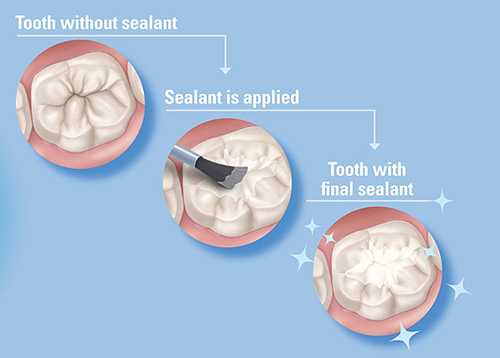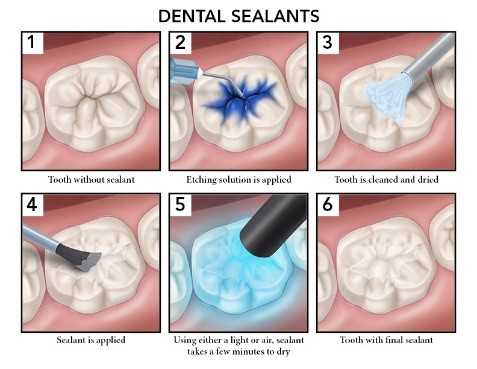Dental Sealant FAQs
What are dental sealants?
Dental sealants are thin coatings that when painted on the chewing surfaces of the back teeth (molars) can prevent cavities (tooth decay) for many years. Sealants protect the chewing surfaces from cavities by covering them with a protective shield that blocks out germs and food. Once applied, sealants protect against 80% of cavities for 2 years and continue to protect against 50% of cavities for up to 4 years.

What is a cavity?
A cavity is a permanent hole in a tooth. If it is not treated, it will get bigger; it can hurt and get infected. The most common place for cavities is in the grooves of the back teeth.
Is sealing a tooth better than filling the cavity?
Sealants are a quick, easy, and painless way to prevent cavities. A tooth without a cavity is stronger and healthier than a tooth with a filling or untreated decay. Sealants are also less expensive and easier to apply than fillings.
Should I ask the dentist to put sealants on my child’s teeth?
Yes. Dental cavities are one of the most common chronic conditions among children and teens. Left untreated, cavities can cause pain and infection and problems in eating, speaking, and learning. Sealants are an extremely effective yet underutilized shield that protects children’s teeth from cavities.
When can my child get sealants?
Sealants prevent the most cavities when applied soon after permanent molars come into the mouth (around age 6 for 1st molars and age 12 for 2nd molars).
Will it hurt to get a sealant?
Getting a sealant is easy and does not hurt. The tooth is cleaned and a gel may be placed on the chewing surface for a few seconds. The tooth is then rinsed and dried. Next, the sealant is painted on the tooth. The dentist or dental hygienist also may shine a light on the tooth to help harden the sealant to form a protective shield.

Will sealants make teeth feel different?
Sealants are very thin and fill the pits and grooves of the teeth. Sometimes children can feel the sealant with their tongues for a short while after the sealant is placed.
What do sealants look like?
Sealants can be clear, white, or slightly tinted. Usually, you cannot see a sealant when a child talks or smiles.
How long will sealants last?
Sealants have shown to still work 9 years after placement. However, sometimes they do fall off, so they should be checked at regular dental appointments. If a tooth loses a sealant, the protective shield is gone and the tooth can get a cavity. Missing sealants are easy to replace.
If my water has fluoride, should my child still get sealants?
Yes. Sealants and fluoride both prevent tooth decay, but in different ways. Sealants keep germs and food out of the grooves in the back teeth by covering them with a safe protective shield. Fluoride in drinking water and dental products, such as toothpaste, protects against cavities by making teeth stronger.
Where can my child get sealants?
- Ask your child’s dentist to apply sealants when appropriate.
- Some schools offer sealants as part of a community public health program. Ask if your school has a sealant program. If they do, sign your child up to participate. If they don’t, ask them to start one.
- If you need to find a dentist, use the Insure Kids Now Dentist Locator.
If my child has dental sealants, is there anything else I need to do to protect their teeth?
Sealants are one part of a child’s total preventive dental care. Visit CDC’s Children’s Oral Health for additional ways to prevent cavities.
Related Links
- Page last reviewed: November 9, 2016
- Page last updated: November 9, 2016
- Content source:


 ShareCompartir
ShareCompartir